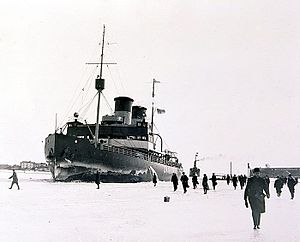
MSV Fennica is a Finnish multipurpose icebreaker and offshore support vessel. Built in 1993 by Finnyards in Rauma, Finland and operated by Arctia Offshore, she was the first Finnish icebreaker designed to be used as an escort icebreaker in the Baltic Sea during the winter months and in offshore construction projects during the open water season. Fennica has an identical sister ship, Nordica, built in 1994.

Kapitan Dranitsyn is a Russian icebreaker, built in Finland for the former Soviet Union. Since October 1995 she has been used as a research vessel by AARI. She also offers excursions in the Arctic Ocean north of Russia.

Vesihiisi was a Finnish 500-tonne Vetehinen-class submarine that was constructed in the early 1930s. The vessel served in the Finnish Navy during the second World War. The name Vesihiisi refers to a mythological Finnish sea creature similar to a Siren.

Taymyr is a shallow-draft nuclear-powered icebreaker, and the first of two similar vessels. She was built in 1989 for the Soviet Union in Finland, at the Helsinki Shipyard by Wärtsilä Marine, by order of the Murmansk Shipping Company. Her sister ship is Vaygach.
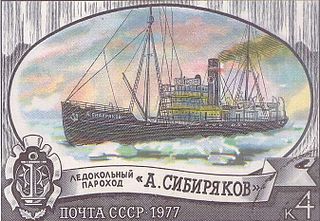
Alexander Sibiryakov was a steamship that was built in Scotland in 1909 as Bellaventure, and was originally a seal hunting ship in Newfoundland. In 1917 the Russian government bought her to be an icebreaker. She served the RSFSR and Soviet Union until 1942, when she was sunk by enemy action. The ship gave notable service in the Russian Arctic during the 1930s.
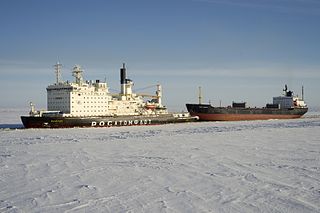
Vaygach is a shallow-draught nuclear-powered icebreaker. She was built in 1989 for the Soviet Union by Wärtsilä Marine Helsinki Shipyard in Finland by order of the Murmansk Shipping Company and its KL-40 reactor was installed at the Baltic Shipyard in St. Petersburg. Her sister ship is Taymyr.

Tarmo is a Finnish steam-powered icebreaker preserved in the Maritime Museum of Finland in Kotka. Built in 1907 by Sir W.G. Armstrong, Whitworth & Co Ltd in Newcastle upon Tyne, United Kingdom, she was the third state-owned icebreaker of Finland and the last Finnish steam-powered icebreaker to remain in service. When Tarmo was decommissioned in 1970, a decision was made to preserve the vessel as a museum ship. After a long wait in Helsinki, Tarmo was towed to Kotka and completely restored in the early 1990s.
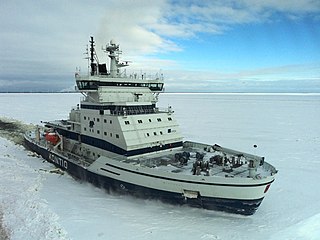
Kontio is a Finnish state-owned icebreaker. Built by Wärtsilä Helsinki shipyard in 1987 as a replacement for the aging Karhu-class icebreakers, she and her sister ship Otso were the first Finnish post-war icebreaker to be built without bow propellers.

Sampo was a Finnish state-owned steam-powered icebreaker. Built in 1898 by Sir W.G. Armstrong, Whitworth & Co Ltd in Newcastle upon Tyne, United Kingdom and named after a magical artifact from the Finnish mythology, she was the second state-owned icebreaker of Finland and the first European icebreaker equipped with a bow propeller. When Sampo was decommissioned and broken up in 1960, she was also the second last steam-powered icebreaker in the Finnish icebreaker fleet.

Murtaja was a Finnish state-owned steam-powered icebreaker. Built in 1890 by Bergsunds Mekaniska Verkstads AB in Stockholm, Sweden, she was the first state-owned icebreaker of Finland and one of the first purpose-built icebreakers in the world. Murtaja remained in service for 68 years until she was decommissioned and broken up in 1958 after having been replaced by the diesel-electric Karhu.

Apu was a Finnish state-owned steam-powered icebreaker built by Howaldtswerke in Kiel, Germany, in 1899. Initially owned by a private shipping company founded by shipowners from the Finnish city of Turku and known as Avance, she was later purchased by the Finnish Board of Navigation and her name was translated into Finnish. Apu remained in service until 1959, when she was replaced by the new diesel-electric Murtaja.

Voima was a Finnish and later Soviet steam-powered icebreaker. Laid down at Werft Becker & Co. in Tallinn in 1916 and fitted with engines in Danzig in 1918, the unfinished icebreaker was towed to Helsinki in 1920 and completed by Sandvikens Skeppsdocka och Mekaniska Verkstads Ab in 1923–1924. After two decades of successful service Voima was handed over to the Soviet Union as war reparation in 1945 and renamed Malygin (Малыгин). She remained in service until 1970 and was broken up in 1971.

Suur Tõll is an Estonian steam-powered icebreaker preserved in the Estonian Maritime Museum in Tallinn. She was originally built for the Russian Empire in 1914 by AG Vulcan in Stettin, Germany, as Tsar Mikhail Feodorovich. In 1917, she was taken over by the Bolsheviks and renamed Volynets. However, in 1918 she was captured by Finland and served as Wäinämöinen until 1922, when she was handed over to Estonia according to the Treaty of Tartu and renamed Suur Tõll. When Estonia was occupied by the Soviet Union in 1940, the icebreaker rejoined the Soviet fleet and was again named Volynets. She remained in service until 1985.
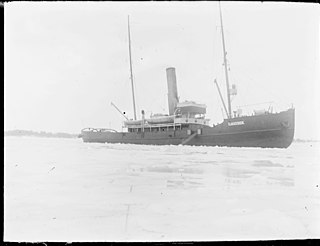
Silatch was a small Imperial Russian and later Soviet steam-powered icebreaker. She was captured by Finland in the aftermath of the Finnish Civil War in 1918 and renamed Ilmarinen until returned to the Soviet Union in 1922. She was decommissioned in the 1950s.

MSV Nordica is a Finnish multipurpose icebreaker and offshore support vessel. Built in 1994 by Finnyards in Rauma, Finland, and operated by Arctia Offshore, she and her sister ship Fennica were the first Finnish icebreakers designed to be used as escort icebreakers in the Baltic Sea during the winter months and in offshore construction projects during the open water season.
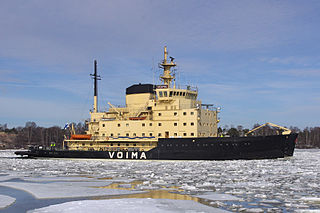
Voima is a Finnish state-owned icebreaker. Built by Wärtsilä Hietalahti shipyard in Helsinki in 1954, she was the first icebreaker in the world to be equipped with two bow propellers and generated widespread publicity that helped the Finnish shipbuilding industry to become the world leader in icebreaker design.

Katarina is a Finnish training ship of the Kotka School of Nautical Studies. Built by Valmet in Helsinki in 1953 as Aranda, she was the second vessel to bear the name. Until 1989, she served as a transport vessel for the Finnish National Board of Navigation and a research vessel for the Finnish Institute of Marine Research.

Polaris is a Finnish icebreaker. Built in 2016 by Arctech Helsinki Shipyard, she is the most powerful icebreaker ever to fly the Finnish flag and the first icebreaker in the world to feature dual-fuel engines capable of using both low-sulfur marine diesel oil (LSMDO) and liquefied natural gas (LNG). Polaris was initially ordered by the Finnish Transport Agency, but the ownership was transferred to the state-owned icebreaker operator Arctia after delivery.

Sisu was a Finnish state-owned icebreaker. Built in 1939 at Wärtsilä Hietalahti Shipyard in Helsinki, she was one of the world's first diesel-electric icebreakers. In addition to icebreaking duties, she served as a submarine tender for the Finnish Navy during the summer months until the end of the Continuation War.

Smetlivy was one of 29 Gnevny-class destroyers built for the Soviet Navy during the late 1930s. Completed in 1938, she was assigned to the Baltic Fleet and played a minor role in the 1939–1940 Winter War against Finland. After the start of the German invasion of the Soviet Union in June 1941, the ship participated in the Gulf of Riga Campaign before withdrawing to Tallinn, Estonia. Smetlivy supported Soviet forces during the defense of Tallinn in August and covered the subsequent evacuation to Leningrad. The ship provided naval gunfire support to the defenders of Leningrad over the next several months before she was assigned to evacuate Soviet troops from their enclave in Hanko, Finland, in November. Smetlivy struck several mines returning from Hanko and sank with heavy loss of life.
